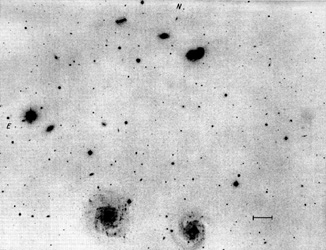


E. The Basic Types of Structures
In the cases observed so far, clouds and patches of luminous matter seem to be strewn about all of the widely separated interconnected galaxies. The actual connections themselves may be of three types, namely
a. The connecting bridge or filament is directly related to some distinct structural feature of the galaxies themselves. For instance the filaments may be the extensions of the spiral arms as it is the case with some of the structures shown on the Plates I, II and IV.
b. There occur distinct filaments which do not show any direct relation to the structural features of the galaxies. We shall see later on that such an absence of visible relation may have come about because of the rotation of the galaxies having destroyed any which might have existed previously.
c. There are no very distinct filaments at all, but all of the member galaxies of a group may be imbedded in a large luminous cloud. Formations of this type are very frequent, but they are difficult to reproduce photographically. A photograph and drawing of one of these groups are shown in Plate VI and Fig 2.

|
Plate VI. 200-inch telescope photograph of a group of galaxies located at R.A. 122 4m 11s; Decl. +9°16'50". Scale = 1' arc. |

|
Figure 2. Drawing of the group of galaxies shown in Plate VI. Perhaps five or six galaxies are interrelated by a complicated cloudy and filamentary structure of luminous matter. Notice in particular the large dwarf galaxy of very faint surface brightness. Scale = 1' arc. |